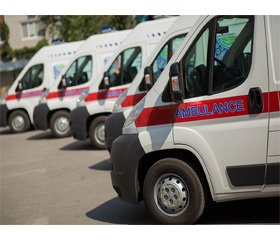Журнал «Медицина неотложных состояний» 2 (65) 2015
Вернуться к номеру
British Experience in Providing Emergency Care to Victims with Severe Polytrauma
Авторы: Pylypenko M.M. - National Medical Academy of Postgraduate Education named after P.L. Shupyk, Kyiv, Ukraine
Рубрики: Медицина неотложных состояний
Разделы: Справочник специалиста
Версия для печати
In this paper we want to share experiences of my two weeks fellowship in the UK with thoracic surgeon O. Linchevskiy at the end of 2014. The main purpose was to attend the Advanced Trauma Live Support (ATLS) course. Due to help of Iryna Rybinkina and other our partners of British-Ukrainian Symposium project we was able to see the implementation ATLS in practice of emergency and intensive care for severely injured patients in London and its satellite city of Brighton.
Teaching the course ATLS has differences from the system of postgraduate training of polytrauma in Ukraine and main distinctive their features are:
— 2 weeks before the course all participants received the latest version of the ATLS textbook (manual), and 40quite complex pretests that would approach the students to study topics and enable to prepare for the final tests and exam;
— a large number of classes (trainings) and their high intensity;
— the ratio for of practical classes, lectures and seminars about 3:1:1, so the number of practical classes far outstrips the number of lectures;
— lectures delivered by the same standard slides as over the world;
— a clear structure for workshops and strict keeping of timing;
— simultaneous involvement of a large number of highly qualified lecturers and trainers from all over UK;
— clear division of students into small groups or subgroups depending of the complexity of skills were trained;
— interest of teachers to learn practical skills by students;
— willingness of teachers to voluntarily played the role of victim and made it possible to demonstrate a skill diagnosis and primary care;
— this course seems expensive for us but lots of UK doctors are waiting quite long time to participate them for their own money;
— examinations for these courses is much more complex than those that our doctors past during postgraduate education in Ukraine.
Besides the already mentioned systems ATLS in UK exist other systems providing of trainings in emergency care for trauma such as PHTLS, ATACC, etc. Thus the British doctors (emergency care, anaesthesiologists, trauma, surgery) working or planning to work with trauma or combat injuries always have possibility to improve their skills in a variety of courses and workshops.
The structure of emergency care in London: 4 major trauma centres where severe injured patients are being taken from the scene. The most powerful is the trauma centre clinic Royal London, new, gigantic and ultramodern building which opened in 2012. On the roof of this hospital situated and perform duty the Heliсopter Emergency Medical Service — London HEMS.
We also had a chance to see the emergency services in, which is the largest city in Brighton (East Sussex) and it is similar to the service in London. It is interesting that significant proportion of funding for specialized helicopter evacuation services carried out by charitable contributions and donations from individuals and organizations. Unlike conventional health care services, where prehostital emergency care runes out almost by paramedics in the emergency service for severe trauma are working the most qualified and trained emergency physicians (with a minimum six-month experience in anaesthesia and in surgery). They are familiar the most important anesthetic and surgical methods and techniques for the first aid.
Distinctive feature of emergency care in polytrauma includes using a team approach with clearly defined responsibilities for each of trauma team members. Patients with severe trauma and hemorrhagic shock could be treated with transfusion, active warming, oxygen inhalation even prehospitaly in emergency car or in helicopter. Otherwise such treatment carried on in the first few minutes after admission to the trauma center. The patient was immediately establishing monitoring of pulse oximetry, invasive measuring of blood pressure, capnography, ECG, blood gas analysis and checking of other laboratory parameters. All urgent diagnostic procedures (especially radiologic examinations) are performed in an emergency department, and then a patient immediately enters the operating room. This intensification of treatment in the first “golden hour” helps to reduce the duration of the shock and improves outcome.

